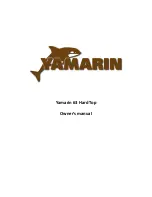
220 Select
1.4
S
ECTION
1 • S
AFETY
•
Do not idle engine without moving boat for more
than 15 minutes at a time.
•
Inspect the exhaust system regularly. (See
Section 8, Required Inspection, Service and
Maintenance).
If CO poisoning is suspected, have the victim breath
fresh air deeply. If breathing stops, resuscitate. A
victim often revives, then relapses because organs
are damaged by lack of oxygen. Seek immediate
medical attention.
5. L
IFESAVING
E
QUIPMENT
Even strong swimmers can tire quickly in the water
and drown due to exhaustion, hypothermia, or both.
The buoyancy provided by a personal flotation
device (PFD) will allow the person who has fallen
overboard to remain afloat with far less effort and
heat loss, extending survival time necessary to find
and retrieve them.
Boat operators are required to carry one wearable
personal flotation device (Type I,II,III or V) for every
person on board. Boats must also have at least one
throwable device (Type IV).
The law requires that PFD’s must be readily
accessible, if not worn. “Readily accessible” means
removed from storage bags and unbuckled. But,
children and nonswimmers must wear PFDs at all
times when aboard. It is common sense to have
everyone on board wearing PFDs. A throwable
device must also be right at hand and ready to toss.
A
. PFD C
LASSIFICATIONS
Off-Shore Life Jacket (Type I) –
most buoyant, it is designed to
turn an unconscious person face
up; used in all types of waters
where rescue may be slow,
par ticularly in cold or rough
conditions.
Near-Shore Life Vest (Type II) –
“keyhole” vest with flotation-filled
head and neck support is also
designed to turn a person face up,
but the turning action is not as
pronounced; used in calm, inland
waters or where quick rescue is
likely.
Flotation Aid (Type III) – vest is
designed so conscious wearers
can turn face up; often designed
for comfor t while engaged in
sports such as skiing.
Throwable Devices (Type IV) –
horseshoe buoys, ring buoys and
buoyant cushions are designed to
be grasped, not worn.
Special-Use Devices (Type V) –
sailboat harnesses, white-water
vests, float coats, and hybrid vests
which have minimum inherent
buoyancy and an inflatable
chamber.
Before purchasing PFDs, ensure
that there is an attached tag indicating they are
approved by the U.S. Coast Guard or by your
national boating law enforcement agency.
Children and nonswimmers must wear PFDs
at all times when aboard. All passengers and
crew should wear them. A loose PFD is often
useless in an emergency.
The operator is responsible for instructing everyone
aboard on the location and use of PFDs.
Size PFDs for the wearer. Children require special
attention in the use of PFDs.
Test PFD buoyancy at least once a year.
(F
IG
. 1.4.2)
(F
IG
. 1.4.1)
(F
IG
. 1.4.3)
(F
IG
. 1.4.4)
(F
IG
. 1.4.5)
Summary of Contents for 220 Select
Page 1: ...220 Select Owner s Manual Part Number MRP 1803639 Sea Ray Owner s Manual...
Page 2: ......
Page 4: ...220 Select II...
Page 12: ...220 Select X THIS PAGE WAS LEFT INTENTIONALLY BLANK...
Page 30: ...220 Select 1 18 SECTION 1 SAFETY THIS PAGE LEFT INTENTIONALLY BLANK...
Page 52: ...3 8 SECTION 3 USING YOUR BOAT 220 Select THIS PAGE WAS LEFT INTENTIONALLY BLANK...
Page 60: ...4 8 SECTION 4 BILGE UNDERWATER GEAR 220 Select THISPAGEWASLEFTINTENTIONALLYBLANK...
Page 72: ...6 10 SECTION 6 ELECTRICAL SYSTEM 220 Select THIS PAGE INTENTIONALLY LEFT BLANK...
Page 84: ...7 10 SECTION 7 OPTIONS ACCESSORIES 220 Select THIS PAGE INTENTIONALLY LEFT BLANK...
Page 94: ...220 Select 9 4 SECTION 9 CARE REFINISHING THIS PAGE WAS LEFT INTENTIONALLY BLANK...
















































